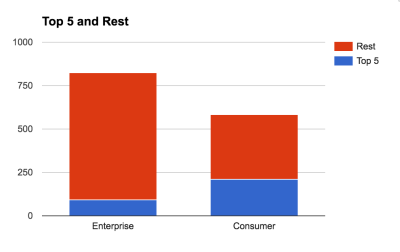
MMS • RSS
Article originally posted on Data Science Central. Visit Data Science Central
Summary: Getting an AI startup to scale for an IPO is currently elusive. Several different strategies are being discussed around the industry and here we talk about the horizontal strategy and the increasingly favored vertical strategy.
 Looks like there’s a problem brewing in AI startup land. While AI is most certainly destined to be the next great general purpose technology, on a par with the steam engine, the automobile, and electrification, there just aren’t any examples of new AI-first companies that look like they’ll grow that big.
Looks like there’s a problem brewing in AI startup land. While AI is most certainly destined to be the next great general purpose technology, on a par with the steam engine, the automobile, and electrification, there just aren’t any examples of new AI-first companies that look like they’ll grow that big.
OK, in the 80s it took a long time for the ‘computer age’ to show up in the financial statistics and maybe we’re at the same place. Still, a bunch of people, especially VCs are wondering how to grow an AI company all the way to IPO. This is just now beginning to lead to several different visions of what a successful AI strategy should look like.
Recently we wrote about our own favorite strategy, Data Dominance. There are two or three others you should be aware of and we’ll talk here about two leading strategies, horizontal and vertical.
How Do We Know There’s a Problem?
In 2017 CB Insights reports that of the 120 AI companies that exited the market, 115 did so by acquisition. And the majority of those acquisitions were made by just 9 companies. Guess who.
 AI startups are only a few years old and it’s fair to say that when those founders started out they hoped not only to change the world but to make some life-changing money. That traditionally means IPO.
AI startups are only a few years old and it’s fair to say that when those founders started out they hoped not only to change the world but to make some life-changing money. That traditionally means IPO.
But thanks to the shortage of AI talent, most of these startups ended up being nothing more than acquihires. We hope that at least some made that life-changing money but all those guppies ended up swallowed by whales and are now just features or products, not world changing businesses.
Not all startups will make it. And it certainly requires some soul searching when Google or Amazon come calling. But there’s an open question about whether the strategies of these startups was viable, and that’s where our conversation begins.
Horizontal Strategy
The horizontal strategy is where our industry started, almost by accident. The core concept is to make an AI product or platform that can be used by many industries to solve problems more efficiently than we could before AI.
Then came what VCs refer to as the monoliths: Google, Amazon, IBM, and Microsoft. As we now know, their dominance in their respective areas of data gave them an almost insurmountable lead in offering generalized image, video, speech, and text AI tools using the familiar MLaaS model.
None of these companies started out to be AI-first companies. This grew out of the phenomenon that was once called the data-sidecar strategy. It was there, so why not add it to their offerings.
The monoliths have become so dominant that there’s a widely held principle among VCs that startups should have a maximum distance from these core competencies in order to be defensible.
There’s a second tranche of horizontal competitors below the monoliths including startups. These reach all the way down to some of the newer automated machine learning (AML) companies like OneClick.AI who integrates deep learning with the standard assortment of ML algos.
Horizontal Strategy is Out
The bottom line is that the horizontal strategy is out for a variety of reasons.
- Thanks to the open source ethos of AI there’s really no defensible IP in any ‘proprietary’ DL algorithms that can’t be copied by a fast follower.
- Horizontal companies don’t own the customer’s core problem. They simply provide a tool that must either be adapted by consultants familiar with that industry, or requires the client customer to learn more about DL than they probably wish to.
- They don’t own the training data unique to the customer’s problem so there’s no data defensibility.
- These tools tend to be incrementally better than their traditional MLaaS counterparts, but not break through better. This includes direct competition from the monoliths.
In short, this is not where VCs are putting their money.
Vertical Strategy
The vertical strategy isn’t the only alternative but it’s certainly the most widely talked about these days. It shares the concern over data dominance with that strategy but goes further in specifying other aspects required for success.
The most vocal advocate for vertical is Bradford Cross, a founding partner at Data Collective DCVC, self-described as the world’s leading machine learning and big data venture capital fund. I don’t know if Bradford is the inventor of the vertical strategy but he can certainly claim to have published more in detail than others.
The vertical strategy has four primary principles:
- Full Stack Products: Provide a full-stack fully-integrated solution to the end customer that solves a true ‘hair on fire’ problem. Full stack means from interface to the DL models to the data that drives the models, and all the functionality in between.
- Subject Matter Expertise: Pick an industry and focus. This requires deep subject matter expertise beyond deep learning. This means bringing in industry leaders early in the process which greatly facilitates not only defining and addressing the problem, but also addresses trust and relationships within the industry when it’s time to go to market.
- Proprietary Data: Owning the interface allows you to instrument it and gather proprietary data. Then you are able to build high value models that drive the acquisition of additional data in that virtuous cycle of customer – application – data. You control the data value chain giving you both data dominance and pricing power. In most instances, determining how to acquire the initial data will be the most difficult aspect of this strategy.
- AI Must Deliver the Core Value: AI is not an incremental add to the solution, it is the core to unlocking a totally new opportunity. AI plus proprietary data gathered with the product itself should allow you to build increasingly attractive and valuable solutions for the industry.
If you’d like to read more from Bradford on the Vertical Strategy try this excellent article.
Is That All There Is to the Vertical Strategy?
Well no. For starters, as we pointed out in our Data Dominance article, picking the right industry with the right problems suitable for AI is no small challenge.
Although any industry that meets the criteria for the vertical strategy might be ripe for defensible exploitation, Bradford Cross adds some insight unique to the VC world.
First of all, Mr. Cross quotes that 90% of AI startups are focused on enterprise markets, not consumer apps that have been so common up to this point.
“Compared with consumer startups since 1995, enterprise startups have returned 40% more capital overall. Enterprise and consumer startups have generated equivalent IPO value, but enterprise has generated 2.5X the M&A value.” 
Second, market exits come in cohorts. Interest in ML and AI in the M&A market tends to occur in groupings around hot industries in which a number of viable startup targets arise together. Right now that tends to favor fintech and healthcare, followed perhaps by energy, utilities, basic industry, and transportation.
The point is simply that there are going to be more buyers in the market if you are a member of a cohort focusing on a hot industry.
Does this mean you should skip opportunities in other industries? Not at all. Just be aware that VCs are more likely to be generous with funding in favored industries than in outliers.
An Observation about Full-Stack Solutions
In general I agree with the desirability of a full-stack solution, one that provides an easy interface and solves a really important customer problem. It’s worth backing up a minute however to consider how much full-stack is enough full-stack.
Using predictive maintenance in IoT as an example, a recent BCG report listed all of the following as part of the total solution for full-stack predictive maintenance solution.
- Identifying at-risk component failure prediction.
- Optimizing resource scheduling and staffing.
- Matching technician and Inventory to the maintenance and repair work to be done.
- Ensuring tools and repair equipment availability.
- Ensuring first-time-fix optimization.
- Optimizing parts and MRO inventory.
- Predicting component fixability.
- Optimizing the logistics of parts, tools and technicians.
- Leveraging cohorts analysis to improve service and repair predictability.
- Leveraging event association analysis to determine how weather, economic and special events impact device and machine maintenance and repair needs.
As you can see, providing this full-stack solution is a tall order. Pretty much on the scale of inventing a SAP or PeopleSoft integrated ERP solution. Would this be defensible – you bet. Is this necessary in the original vision of your AI-first business solution – probably not.
As a longer-term goal this would be an ideal case but you can probably build a significant business on just 3 or 4 of these elements.
Looking back at the examples from our previous article, Blue River Technology, Axon, and Stitch Fix, these three are well on their way to defensible businesses using data dominance as their core goal. Will they grow to full-stack at some point – perhaps, but the solutions they currently offer are very high value.
What they share with the vertical strategy beyond data dominance is subject matter expertise and AI-first value creation. Full stack, however you wish to interpret that can follow so long as the application solves the immediate customer problem easily, efficiently, and accurately.
Other articles on AI Strategy
What Makes a Successful AI Company
AI Strategies – Incremental and Fundamental Improvements
Other articles by Bill Vorhies.
About the author: Bill Vorhies is Editorial Director for Data Science Central and has practiced as a data scientist since 2001. He can be reached at: